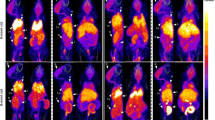Abstract.
During the period February 1997 to April 2000, 15 patients with clinical symptoms of Creutzfeldt-Jakob disease (CJD) were referred to Uppsala University PET Centre. Positron emission tomography (PET) was performed to detect characteristic signs of the disease, e.g. neuronal death and/or astrocytosis in the brain. The examinations were performed in one session starting with oxygen-15 labelled water scan to measure regional cerebral blood flow, followed by imaging with the monoamine oxidase B inhibitor N-[11C-methyl]-L-deuterodeprenyl (DED) to assess astrocytosis in the brain and finally imaging with fluorine-18 2-fluorodeoxyglucose (FDG) to assess regional cerebral glucose metabolism (rCMRglu). Nine of the patients fulfilled the clinical criteria of probable CJD. In eight of them, FDG and DED imaging revealed, in comparison with normal controls, a typical pattern characterized by a pronounced regional decrease (<2SD) in glucose brain metabolism, indicative of neuronal dysfunction; this was accompanied by a similar increase (>2SD) in DED binding, indicating astrocytosis. These changes were most pronounced in the cerebellum and the frontal, occipital and parietal cortices, whereas the pons, the thalamus and the putamen were less affected and the temporal cortex appeared unaffected. The cerebral blood flow showed a pattern similar to that observed with FDG. In the ninth patient, analysis with DED was not possible. The diagnosis of definite CJD according to international consensus criteria was confirmed in six of these patients. In one patient with probable CJD, protease-resistant prion protein (PrPres) could not be demonstrated. In two patients with probable CJD, autopsy was not allowed. Computed tomography and magnetic resonance imaging, performed in four and seven of these nine patients respectively, showed unspecific, mainly atrophic changes. In six other patients, the PET examinations gave a different pattern. In three of them, high rCMRglu was noticed in parts of the brain, particularly in the temporal lobes and basal ganglia, which could suggest encephalitis. One of the patients had Sjögren's syndrome, one had paraneoplastic limbic encephalitis and the third recovered spontaneously. In the other three patients, the DED binding was normal despite a hypometabolic glucose pattern. In conclusion, the PET findings obtained using DED and FDG paralleled neuropathological findings indicating neuronal dysfunction and astrocytosis, changes that are found in CJD.
Similar content being viewed by others
Author information
Authors and Affiliations
Additional information
Electronic Publication
Rights and permissions
About this article
Cite this article
Engler, H., Lundberg, P., Ekbom, K. et al. Multitracer study with positron emission tomography in Creutzfeldt-Jakob disease. Eur J Nucl Med 30, 85–95 (2003). https://doi.org/10.1007/s00259-002-1008-x
Received:
Accepted:
Issue Date:
DOI: https://doi.org/10.1007/s00259-002-1008-x




